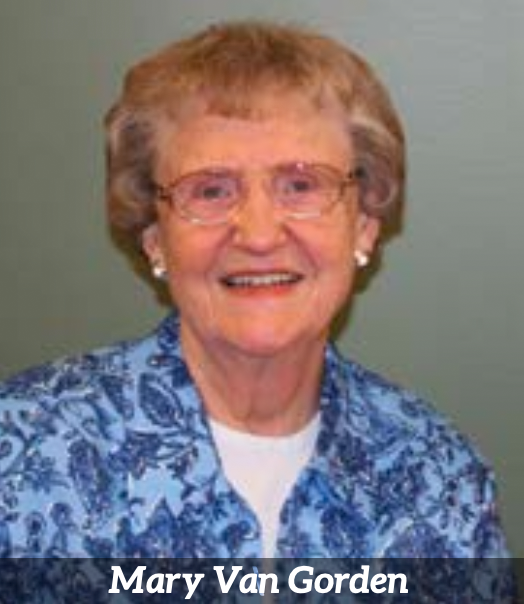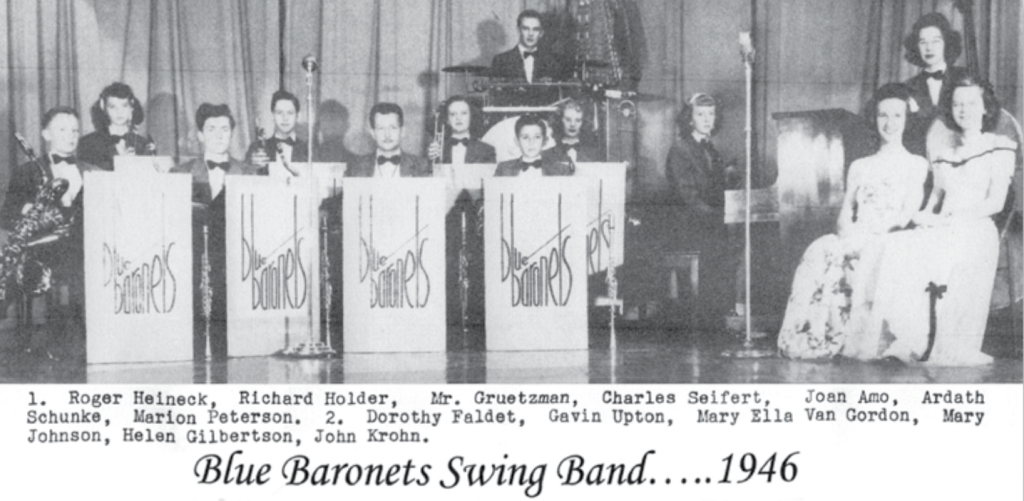Mary was born at home in Black River Falls on January 10, 1930, to Kathleen and J. Bruce Van Gorden. Older sister Jo Ann was already on the scene. Sister Beth followed in 1934. (There was no hospital in Black River until 1932.)

Mary readily expresses appreciation for having grown up in a small town where the whole town was a playground for kids, every season of the year. “We roller skated after school; we played ‘Hide & Seek’ in the evening; and in winter we went sliding on the Pierce Street hills ‘til the street lights came on.” Mary’s essay “Why I Like My Hometown” won first prize in a national contest sponsored by Scholastic Magazine when she was in high school.
Mary not only enjoyed life in Black River but loved being at the family cottage in Hatfield every summer beginning in 1932. Members of her family were early campers at Hatfield, even before the dam was built and Lake Arbutus was formed in 1908.
Mary’s memories of Junior High School include efforts to help fight World War II. “We kids went out every Saturday collecting scrap metal all over town, and on Mondays we brought our dimes to school to buy War Stamps. We liked to think we helped win that war.”

In high school Mary enjoyed all activities involving music. She sang in the mixed chorus and played in the band and orchestra. Most memorable was the swing band the “Blue Baronets,” which played at proms and dances all over the area. At one point the band became such competition for other local bands that members were persuaded to join the union. “We carried American Federation of Musicians union cards in high school.” Mary also sang in her church choir, which she continues to do today. For her music achievements she was given the “Adele W. Barber Music Award.” Many years later Mary helped organize
a benefit concert in Black River to raise money for the new Wisconsin Center for Music Education in Waunakee, WI.
Mary was graduated as valedictorian of the Class of 1947 and then went on to study occupational therapy at Milwaukee- Downer College (now a part of Lawrence University). During her college years she spent part of each summer counseling at a camp for underprivileged children, a very revealing experience.
The Korean War was in full force in 1951, and medical personnel of all kinds were being recruited to help. Mary and seven classmates responded and joined the United States Army as Second Lieutenants immediately after graduation. Mary spent the next two years at Brooke Army Hospital, Fitzsimons Army Hospital, and Madigan Army Hospital. She was discharged in 1953 as a First Lieutenant and went on to graduate school at New York University, receiving her Master of Science degree in 1954.

After working as an occupational therapist at University Hospitals in Minneapolis, Mary moved to Duluth to help build a new rehabilitation center for the Twin Ports. She served as Executive Director of what became the Polinsky Medical Rehabilitation Center for 25 years, with the exception of six months spent in Milwaukee as Editor of the American Journal of Occupational Therapy.
Mary loved Duluth and became active in community and professional affairs, including serving on numerous boards and committees at the local, state, and national levels. For her accomplishments she was awarded citations by both the Mayor of Duluth and the Governor of Minnesota.
To be of assistance to her parents Mary moved back to Black River in 1980. Leaving Duluth was not easy, but her deep feelings for her hometown made the move exciting. A friend commented at that time that “chickens always come home to roost.”
Because she had spare time Mary became active in volunteer activities, particularly at Black River Memorial Hospital, where she was trained as its first Lifeline installer. She also served on the Hospital’s Board of Directors. In 2003, she chaired the fund drive committee to establish the hospice program and that same year became a member of the Hospital’s Building Fund Campaign Committee. She continues today as an active member of Partners.

For 10 years Mary served on Pine View Nursing Home’s Board of Directors and helped establish the Pine View Endowment Fund prior to the selling of the facility.
Gil Homstad recruited Mary in 1985 to develop a program for senior customers at the Jackson County Bank. This was the launching of the Prime Time Club, which Mary coordinated for nine years, during which time the membership grew to 1,200. She also was affiliated with the Bank as a member of its board of directors for 12 years, being a fourth generation member of that board and its first woman director.
United Methodist Church activities have been a priority in Mary’s life, and throughout the years she has served in numerous capacities. She was Chairman of the Building Committee when the new sanctuary was built in 1993/94 and also assisted with the capital fund drive.
In 2005, Mary and several friends met at Skyline to initiate plans for a support group for Skyline. Out of their efforts grew Skyline Friends, which was launched officially two years later.
Mary traveled a great deal in years past, sometimes doing family history research as far away as Ireland, England, Germany, and the Netherlands. Genealogy has been her favorite hobby for over 50 years. When a new library was proposed for Black River, Mary offered to help plan and pay for a Jackson County History Room in the Library to make sure the history of our county and its people is preserved, appreciated, and made available. The library and its history room opened in 1995.
To help maintain the history room Mary established an endowment fund with the Black River Falls Area Foundation. She later set up a Charitable Fund with the Foundation to be used for other needs in the area. She also played a role in creating Alma Center’s Turtle Pond Park (see article below) and its Alma Center Area Community Fund, the Foundation’s first geographic affiliate. Mary’s interest in Alma Center stems from having ancestors who homesteaded there in 1854.
When asked about her use of the Foundation she replied, “It’s a truly great asset for our community, with admirable goals and management. The Foundation has been a perfect vehicle for my philanthropic goals, allowing me to do what I could not do alone.” And when she speaks of “doing things alone,” Mary is quick to give credit to her parents for making it possible for her to carry on her charitable work in this community.
Another vital community asset which has been important in Mary’s life is the Lunda Charitable Fund, for which Mary has been a board member since its inception in 1988. She considers it a rare privilege to have been involved in the work of this significant fund. Mary has also been proud to be a volunteer for Jackson County Interfaith Volunteer Caregivers throughout the years and continues to be awed at the many ways this organization helps make Jackson County a great place to live, for people in all walks of life.
In 1996, Mary received Rotary’s “Community Service Award,” and in 2000 she was a recipient of the “Jackson County Women in History Award.”
While serving on the Jackson County Housing Authority Mary became aware of the need for non-subsidized congregat housing for seniors and in 1995 joined Mike Anderson’s group which was making plans to meet this need.
Those plans did not develop but were revived by Mike in 2012, leading to the building of Spaulding Place, which opened in 2015. For her work as a prime mover in making Spaulding Place a reality, Mary was given the “Cooperative Spirit Award” by the Senior Cooperative Foundation at their annual meeting in Bloomington, MN, on May 29, 2019.
When asked what she sees as remaining needs in our community, Mary stressed the fact that our country has an aging population. In Wisconsin the over-65 population is expected to double by 2030, which will present many challenges as
we seek ways to care for our deserving senior friends and neighbors, right here in Jackson County.
